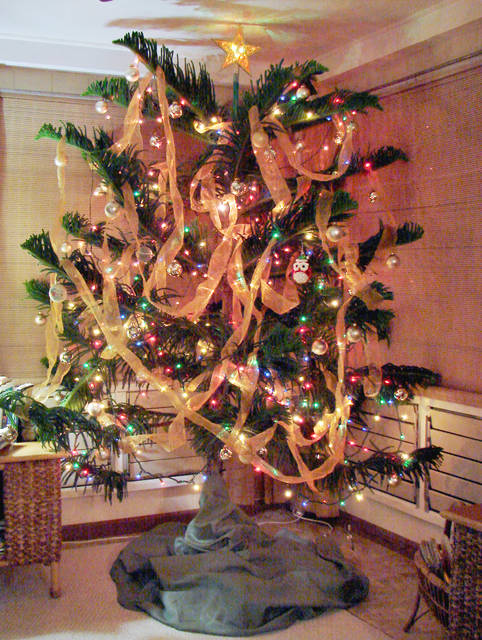The young Norfolk pine tree in its black plastic tub seemed to be awaiting me in the entry of a local shop about five years ago. This would be no Charlie Brown tree, with its perfect shape — almost as perfectly layered even at its 4-foot stage as a kid’s representational drawing of a standard Christmas tree.
My husband hefted the tree, tub and all, into the back of his car. Once home, we lifted it up onto a small table. This gave the young tree some height as it reigned over our living and dining room that year, once decked.
After New Year’s, we moved our potted tree onto the patio to soak up the sun and rain and keep on growing. The next December, in it came once again for Christmas, but was not so easy to maneuver. After two years, it was big and heavy enough that we managed to roll it in on a garden dolly only as far as the back screened porch. It starred there during the holiday season, letting us view its lights and ornaments through the sliding glass door.
In 2016, I convinced my husband that our tree had outgrown its original pot and needed to be planted. Dee was dead-set against this, knowing that Norfolks grow to considerable size. Indeed, in our neighborhood, there are some that have reached heights that could threaten the roofs and structure of nearby homes, should they fall. (One set of giants I see while walking are festooned in purple bougainvillea, a spectacular sight — unless downed by storm winds.) I had to do some quick talking to convince him that we’d cut the tree down to bring in for the holidays the next year. “And then,” I reasoned, “we’d have an ever-growing tree,” pointing out that the keiki (child) that emerges at the foot of the parent tree would grow toward yet another December reckoning, and then, again.
He still looked dubious about the planting plan, remembering that a previous potted Norfolk pine we’d given a friend was towering over their home, an arboreal problem. “But that one wasn’t cut,” I offered in support of my plan. “Ours will be.” He relented and helped me dig a large hole to fill with compost for the ceremonial tree planting. This took some doing.
After the first drenching, I made sure to carry buckets of gray water out to the Norfolk during the drier months, and to pull close to it when washing my car. A new layer of branches appeared, and then another.
I kept an eye on the tree, and also admit to communing with it occasionally while dusting out rugs or visiting the mailbox. “Go baby,” I’d say, or “Looking good,” and similar encouragements and affirmations. Occasionally I hosed it down; I chased anoles off it; I removed red spider webs and their occupants from it carefully with a rake, knowing we wouldn’t want arachnids hitching a ride into the house come December.
In July, I noticed a spurt of growth and a keiki sprouting next to the main trunk.
By September, the tree seemed to have shot up noticeably. I hoped it wouldn’t keep increasing its height at such fast pace. “Slow down, tree,” I told it. “Relax.”
December came, and the tree was just right — green and full. I reminded Dee that he’d soon need to get out his chainsaw. At mid-month, I checked the tree over and hosed it down thoroughly.
The next day dawned fair: the moment had come. No sleigh through the woods over the snow to the Christmas tree farm; no axe. Instead, out came the trusty saw, the special oil and the extension cord, which we carried to the southwest corner of our lawn on our mission. After deciding the best angle of attack so as not to harm the up-and-coming keiki, Dee crouched down to fell the Norfolk. I grasped its trunk to guide its fall — and down it came. We upended the cut tree in a bucket of water to hydrate for 24 hours.
Wrestling it inside the next day, we were glad it was no taller than 7 feet. That was heavy and bulky enough. In fact, it took enough work to set it up in the prepared stand that we did nothing more than position and admire the greenness, subtle vegetal aroma and presence of our tree indoors for several days.
Now as the days shorten, bedecked, it shines in the corner of our living room as the symbol of life and family, the synthesis of heaven, earth and water, dynamic life and spirit — all of that, and more. It matters not that the tree has no distinct piney smell. The starry lights I wrote of in the last “Green Flash” (TGI, Dec. 11) have been somewhat replicated on it, and the tree-top star touches the ceiling. We can’t resist stopping and staring, or sitting and staring, and wondering.
“When they saw the star, they rejoiced with exceeding great joy.” (Matthew 2:10 KJV)
One thing we know already, that the keiki-of-Christmas Tree 2017 is not destined to reaching 7 feet. We have a date with it (and maybe a hand saw) next December while it’s a bit more manageable, if less spectacular.
Happy holidays, Dear Readers!
•••
Dawn Fraser Kawahara, resident author and poet, has focused her supportive interests within the Kauai community since the early 1980s. She and her husband, a retired biology teacher, live in Wailua Homesteads. Their passion for travel flows into the writer’s monthly TGI column, “FarAway Places.” Kawahara’s books are available through Amazon and other outlets. More info: tropicbirdpress@gmail.com.





